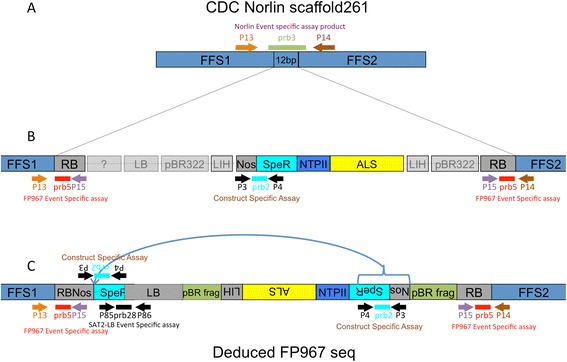Figure 1.

Cartoon of the insertion of the FP967 T-DNA into scaffold 261 of the flax genome. A) The insertion site of the FP967 TDNA into Norlin gDNA at scaffold261. The event specific assay detects uninterrupted gDNA from Norlin using primers P13 and P14 and Taqman prb3. See Tables 1 and 2 for more details. B) Known (in colour) and unknown (opaque grey) portions of the FP967 TDNA at the beginning of the project. The sequences and orientations of the LB and flanking region, the pBR322 fragments and the LIH had not been confirmed. The construct specific assay, which detects the DHFR fragment form E. coli and the Nos terminator, is indicated (P3, P4 and prb2). The event specific assay, developed in this project, is also shown. It uses a primer in Norlin gDNA (P13 or P14), a primer in the RB (P15) and a probe in the RB (prb5) to detect the TDNA. C) Deduced T-DNA structure after NGS and PCR fragment cloning. The inverted portion of the TDNA inserted between FFS1 and the LB is indicated, as is the new event-specific assay, which spans the junction between the SAT2 gene of the SpecR cassette and the LB (P85, P86 and prb28). The orientation and sequence of the LIH, AtALS, NPTII, SpecR cassette and internal Nos gene were deduced. Inverted sections were found to be oriented in the reverse direction.
